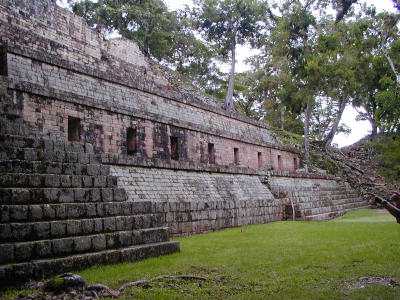
Chapter 2
The Copan Ruins in Honduras, our first look at Mayan history
The ruins of Copan (an ancient Mayan city) are about three miles from the little town of Copan. We stay at a very nice hotel right in the center of town (a banana tree hangs over the swimming pool) — cobblestone streets and three internet cafes.
A gentleman from the Copan private school talked to us that night about the education difficulties in the area. In Honduras, the children are "required" to attend school through sixth grade — but many don’t - and then it’s up to the parents whether their education will be continued. Since the country is 90% agricultural, most parents need the children to work on the farm so very few go on to secondary school. A program that provides a "mid-morning snack" has been quite successful at keeping more kids in school, but it is still difficult — especially since so many of them have to walk 2 or 3 miles to and from. Honduras is not as overpopulated at Guatemala and its democratic government is finally having a good effect.
We had a slide show by David Sodat, who is the archeologist field director of the University of Pennsylvania Copan program. He’s been studying at Copan for 8 years and is here to set things up for the upcoming digging season — starts in January. He emphasized the fact that most of the remains from the Mayan civilization is still underground. A few years ago the river running near the ruins cut under the bank and showed many things that were hidden. Temple 16 has been tunneled to find the Rosita Temple underneath. Most Mayan temples seem to be like onions — if you peel off the top layer, there’s another temple underneath.
The excavation of temple 16 and the "Red Lady" found in the center are well documented in the Dec.’97 National Geographic, if anyone’s interested.
The next day we did our field trip through the ruins — which was one of the most fascinating and impressive times of the whole trip. This was originally one of the largest and most important of the five Mayan capitals — and the most metropolitan, with 30 to 50,000 people living here. The jungle covered mounds were first found by the conquistidors, who of course, dug into many of them looking for gold. But they only found jade, since it was the most precious gem of the Mayans. Many of the Mayan towns/cities were destroyed by the Spaniards, using the building blocks to construct their cathedrals, etc. on top of the original buildings. Copan was luckier since the town was built 300 years later and off to the west of the ruins. Thus there are a lot of things for touristas to gape at — and I did.

The Plaza has two large pyramids that were built during the Classic Period (200 AD — 900 AD) with several stele. These are large stone carvings representing one king, usually his family is represented by masks on his front, and the back and sides are covered with glyphs representing his accomplishments.
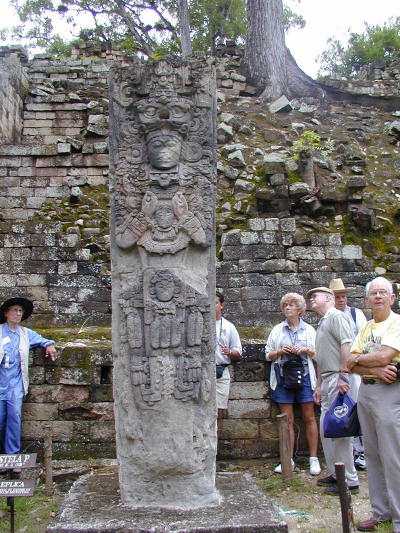
The stelae were monuments built to/for a particular king and are one of the more fascinating artifacts found at Mayan sites.
The king’s nose was always chipped off his statues when he died to signify that he was no longer breathing.
Altar Q is another of the most famous artifacts from Copan because it portrays sixteen different kings handing on their rule — a dynasty that lasted 400 years.
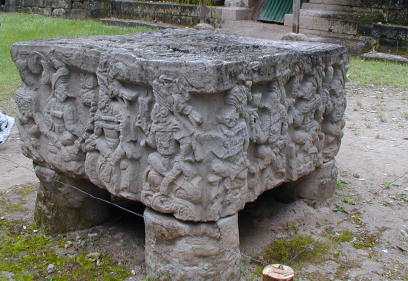
They all had weird names — Smoke Monkey, Moon Jaguar, Eighteen Rabbit (he ruled for 35 years), etc. The deciphering of the glyphs has been going on by various people since early times — but especially in the last fifty years — and is still an ongoing operation.
The Jaguar Plaza was the area where the citizens gathered — like an arena — usually for the bloodletting sacrifices performed by the king (on himself). It was interesting to see a group of children (on a field trip) studying/visiting the site — learning their history.
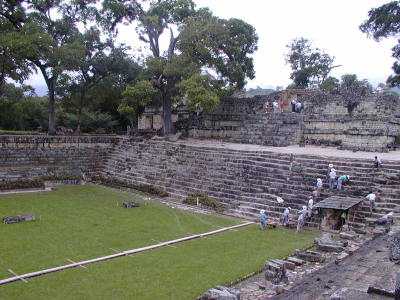
There are a total of 6 plazas — open areas surrounded by large structures — at Copan. The most famous area is around the hyroglyphic stairway which honored four ancient kings. There are 64 steps in the stairway, and it is now covered with a tarp to try to preserve more of the carvings.

Of course, there was also a sacrificial stone at the bottom, since the practice of human sacrifice was requisite at that time.
The ball court in Copan does not have the rings we normally think of in a Mayan ball court. Instead there are 6 macaw heads (the sacred bird) which were the "goals" to be aimed at. In the official games here the losers were sacrificed — other Mayan areas (with the rings) supposedly sacrificed the winners. Even if it was an honor to be sacrificed, I bet the competition became pretty fierce. There were three men on each team, and the theory is that citizen disputes were often settled on the ballcourt — less athletically inclined might stay away from disputes.???
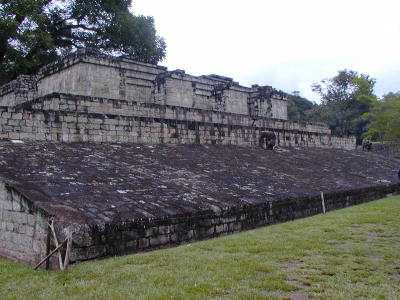
After wandering through the large plaza which houses 18 Rabbit’s seven stelea our group was shown to the sculpture museum where we could see some of the pieces that have been removed from the ruins. The replica (photo below) of the Rosilila pyramid is in the center of the museum — about 40 feet high — and is quite impressive.
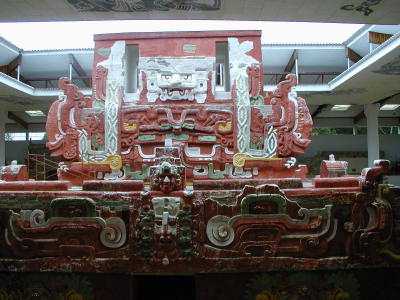
After lectures on the educational system and the medical system in Honduras, our excursion the next day was to ‘Sepulcres’ which seems to have been the "Beverly Hills" of Copan — the rich people lived here. Many jade pieces have been found in this area — and since there is no local quarry for jade — it’s obvious a lot of trade went on in ancient times. Many of the houses were built near rivers and springs and had channels with running water and a sewer system.
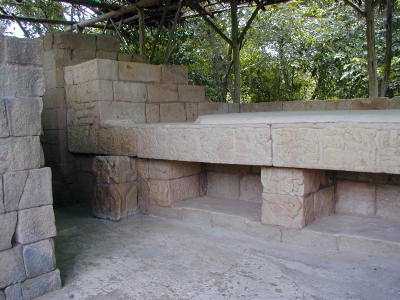
A bench found in the Scribe’s house records his history — figure of young man at one end and old man at other end support the platform.
An area here has been found where experimentation had been going on with the pottery and coloring. This has become quite fascinating to archeologists since they are also trying to figure how the Mayans colored and created some of their pottery.
We also visited the Copan museum back in town where they are preserving the history of the Mayan rise and fall. The early settlers in Copan came from Guatemala in 1100 BC and this area was most famous for its astronomy and mathematics. They had 364 days in a year long before the Europeans came close. The Mayan calendar is very complicated and based on the rotation of two toothed wheels that mesh the Solar calendar of 18 months and 20 days with the Lunar calendar which has 20 periods of 13 days.

With their calendars and astronomical expertise the Mayans could predict eclipses, etc. as precisely as modern scientists.
After an interesting lecture on chocolate — the Mayans used it as currency and only the upper classes actually drank it — we had a delightful barbecue around the pool at our hotel.
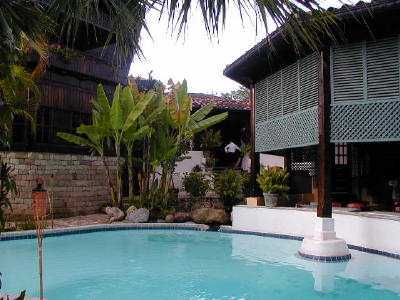
The banana tree hanging over the pool had small green bananas on it.
Click here, more pictures of the Copan Ruins